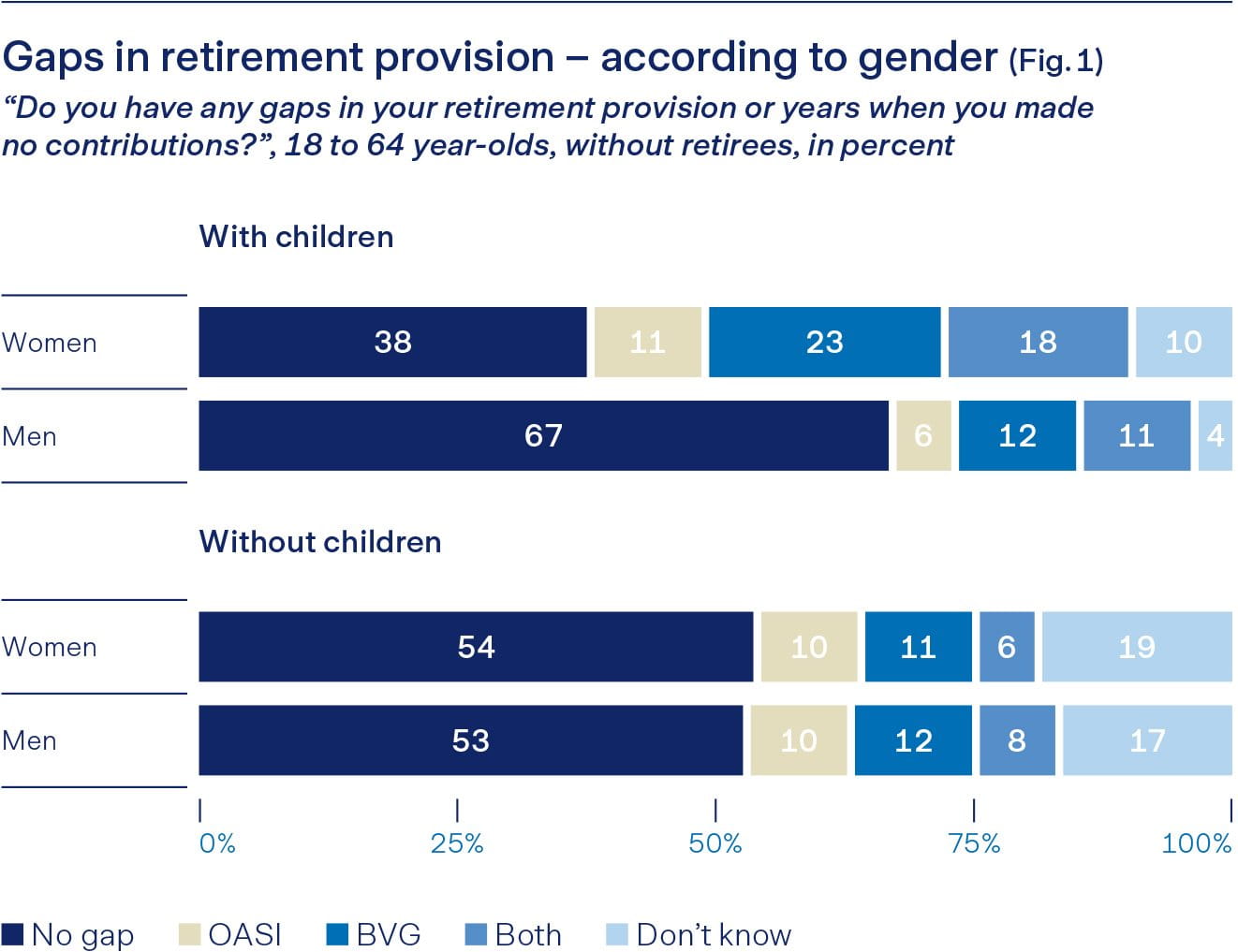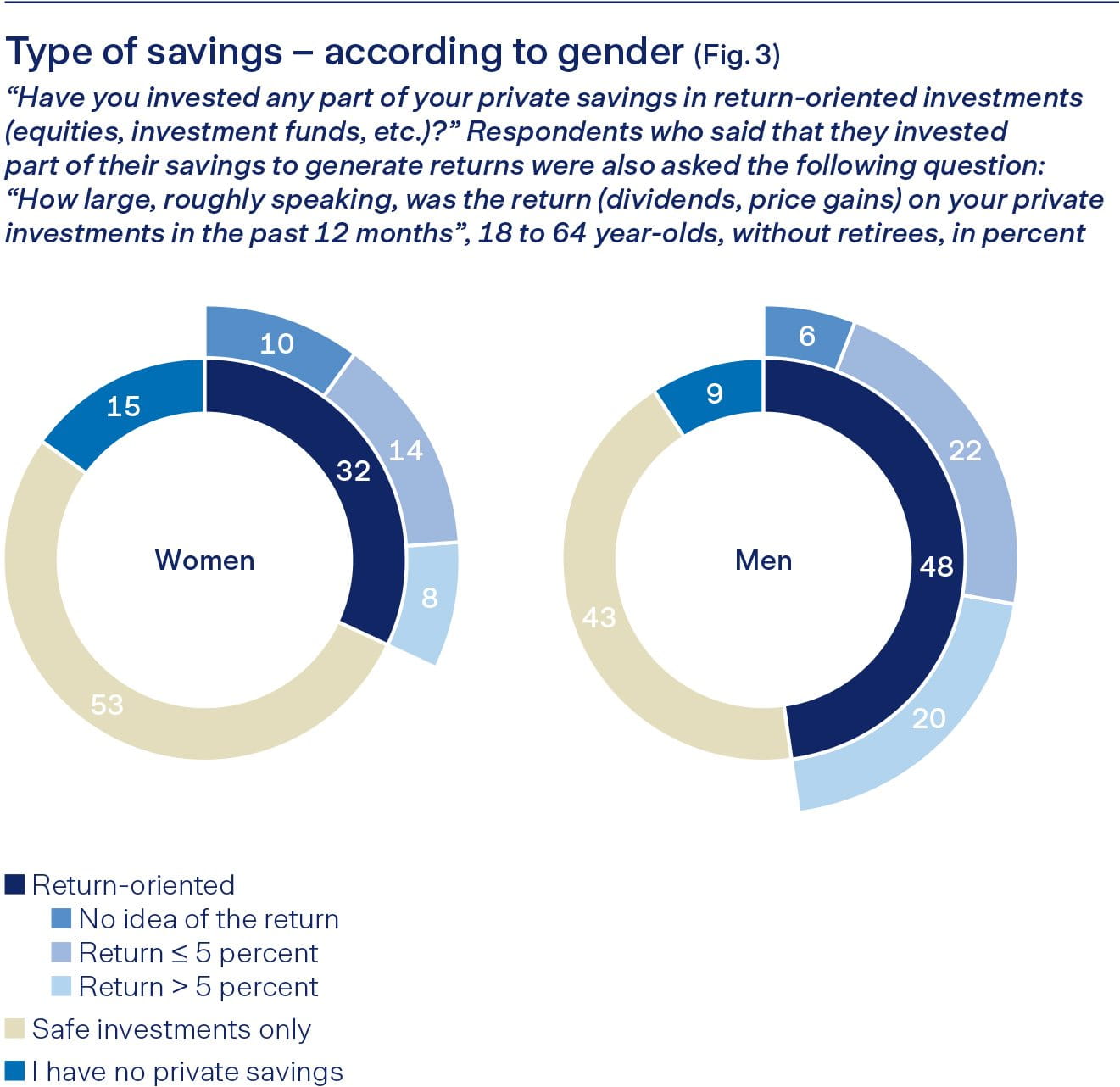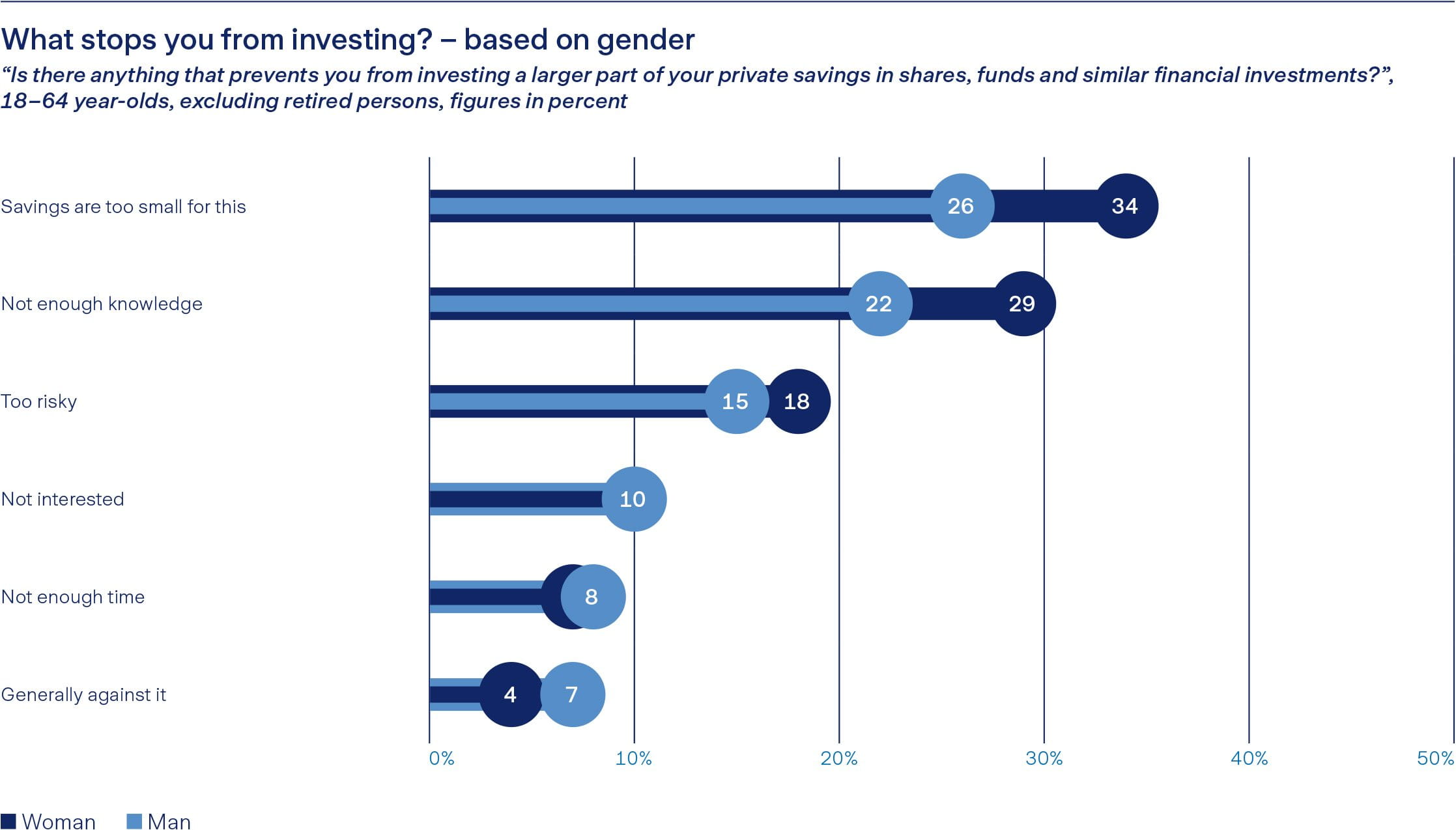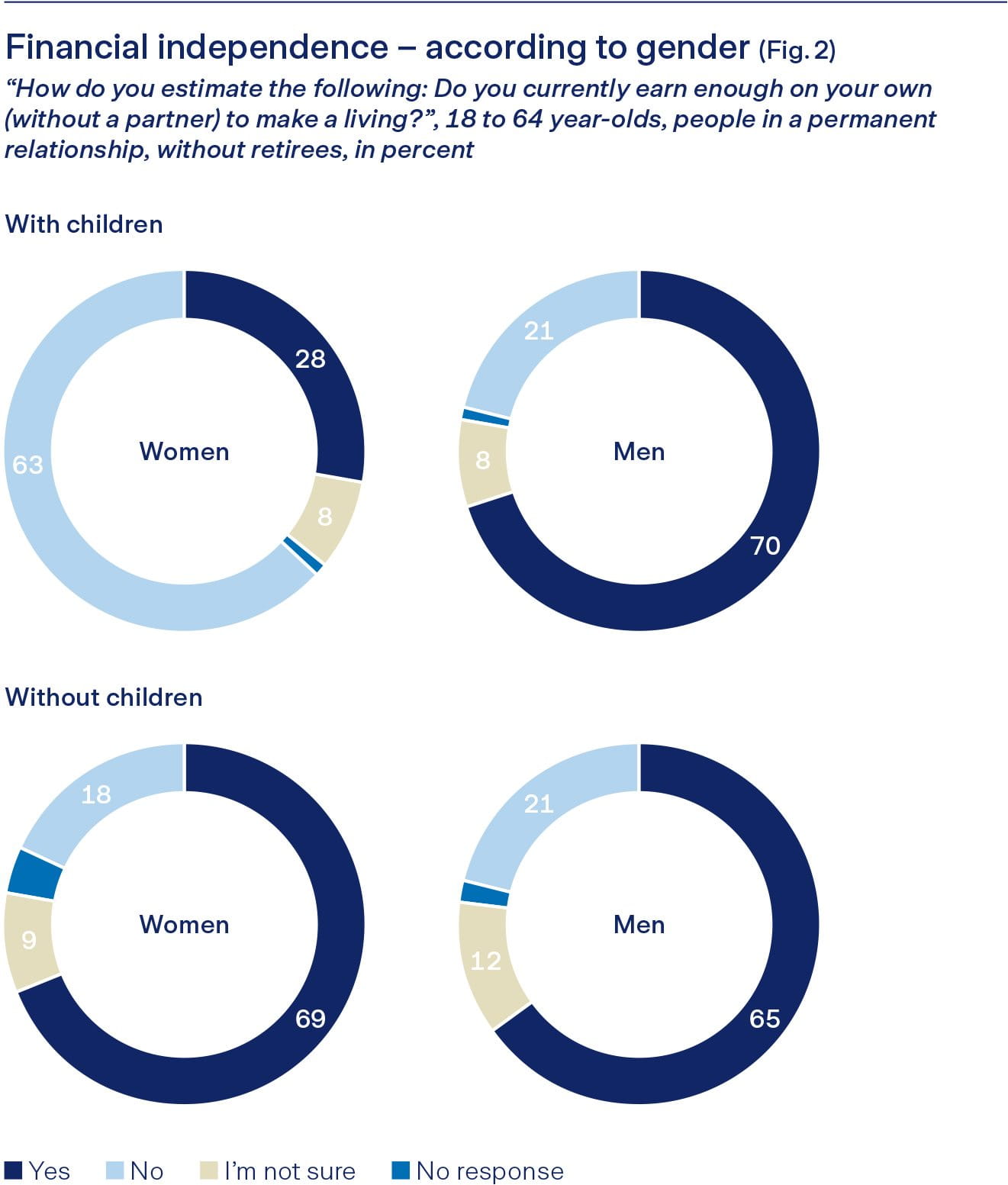Baby joy, a wonderful journey during a sabbatical, or an exciting further education opportunity: there are many good reasons for reducing your workload, either temporarily or for good. What many forget in the process: less pay means lower monthly contributions to retirement provisions. The consequences are often first evident decades later. In the worst case, financial hardship becomes a risk once earnings from gainful employment cease and retirement begins.
As a woman, it is particularly important that you get to grips with your career, family, and financial planning starting today. It is, first and foremost, women with children who are much more frequently affected by contribution gaps in their pension plans than men, according to the study "Frauen und Finanzen – mehr Wissen für gleiche Chancen" [Women and finances – more knowledge to foster equal opportunities] commissioned by Zurich Switzerland and the Verein Geschlechtergerechter [Gender Equality Association] (see Fig. 1). With these tips, you will obtain the know-how required to make the right decisions:

Invest wisely and use the time
The Swiss retirement provision system consists of three pillars. The compulsory monthly payments into OASI (1st pillar) and the pension fund (2nd pillar) are paid automatically from your wages, financed by you and your employer. By contrast, the third pillar is entirely in your hands.
First and foremost, it is important that you pay the voluntary contribution of max. CHF 7,258 into the third pillar every year – even if you have to do without something else. Secondly, it is important that you make the correct investment decision when doing so. As the study shows, there are differences between men and women in this regard. 48% of men invest their private savings in return-oriented options – in funds or shares. By contrast, only 32% of women do the same (see Fig. 3).
Most women invest their savings in the third pillar in a 3a savings account. Their money is not subjected to regular value fluctuations here, as is the case with shares. But since savings have hardly earned any interest in the last few years and the money has quickly lost its value due to record high inflation, savings accounts are constantly losing value at present.
However, with shares the situation looks rather different: even if the value of shares can fluctuate strongly at times and crises occur every so often: over a period of ten years or more, shares have performed far better through nearly all phases than other investment products. This is why it is important to remember that the longer you have until retirement, the greater proportion of your 3a or 3b savings should be in shares.

Do not underestimate yourself
According to the study, there are two reasons why more women put their 3a money into savings accounts instead of equity funds. Firstly, women claim to have too little saved. Around every third woman does not invest in return-oriented assets because their savings are supposedly too small. With men it is around a quarter less (see Fig. “what stops you from investing”). In the first tip you already learned that it is not the amount of savings you have which is decisive, but rather the length of time you invest. The fact that your savings are small at best is the very reason you should take the opportunities offered by the stock market. Provided you have a sufficiently long time horizon available to you.
Second, women are significantly more likely than men to state that they lack the necessary investment knowledge. However, the decisive factor here is that the study did not ask the women what they actually knew but asked them for a self-assessment of their knowledge. That women estimate their financial competence to be less than their male counterparts’ does not at all mean that they are actually capable of less. Regarding finances, it is entirely possible that the opposite is the case: A good mix of competence and caution is an excellent foundation for investing one’s own money wisely. Conversely, the tendency to overestimate one’s ability is a poor foundation.
And should you actually lack the knowledge, countless guidebooks, blogs, and videos provide the required know-how in a concise and entertaining style.

Organize your pension provisions together with your significant other
But why is it that women today face a gap in retirement savings more often than men? The main reason lies in the varying biographies of paid employment, as indicated in the study by the acclaimed research institute Sotomo. As before, many women reduce or take a break from paid employment upon giving birth, whereas becoming a father has a less pronounced effect on men’s working lives.
63% of women in committed relationships said that they currently would not be able to manage solely on their own incomes. By contrast, only 21% of men said the same thing (see Fig. 2).

The tendency for women to have lower incomes has consequences: they pay less into the compulsory pension (1st pillar and 2nd pillar) and also save less privately. Upon retirement, women, therefore, have built up less pension assets than men. For example, 40% of women report having gaps in their contribution payments compared to 30% of men. The study also shows that women seem to underestimate the risks that contribution gaps have for their own financial situations in retirement.
But these problems of many women today need not be your future worries: if you make good decisions and arrangements with your domestic partner, you will have prepared better for your retirement provision. Contribution gaps become a problem first and foremost when relationships end.
For married couples and registered partnerships, the law requires retirement savings built up during the marriage or registered partnership to be shared upon its dissolution or divorce. This means that any gaps affect both persons and are correspondingly smaller.
Persons living in a cohabitation can voluntarily opt for the same rule. It is important that the relevant agreement is in writing and has a binding effect.
At the end of the day, a typical career of paid work is not set in stone: many women today have at least as good an education as their partners. If both reduce their working hours to the same extent after the birth of a child, both will continue to save for retirement without gaps.
Gaps can be closed
Should a gap nonetheless occur during your life in paid employment, it is not the end of the world. Gaps can be closed through various means. This is possible through personal retirement provision – voluntary savings. This includes, as already mentioned, payments into pillar 3a, into a securities deposit account, or voluntary payment into occupational pensions. But life insurance policies, real estate, and other investment options, such as shares, also contribute to absorbing financial deficits in retirement.
Of course, money for such investments may not be available during certain phases of life. The birth of a child or long periods spent in further education can put a significant strain on your personal budget.
However, here you will come full circle in the whole matter: if you begin sorting out your career, family and financial planning early; trust in your own ability; and obtain the right knowledge, you can consciously plan your own career and working life and plan in phases during which you will build extra savings for your retirement.




